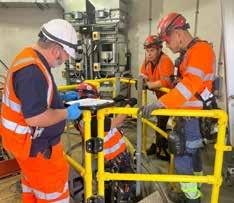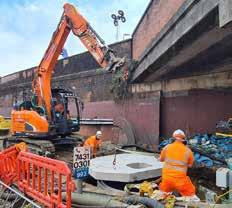
1 minute read
Drainage engineers use “exemplar” safety systems to clean deep railway sump
Rail for London (RfL) commissioned leading rail specialists: Lanes Rail: division of Lanes Group plc, to clean a sump along the 73-mile length of the Elizabeth Line.

Advertisement
The sump in Silvertown, East London, next to London City Airport was 25 metres deep and is the deepest wastewater asset along the length of the new line.
In-house safety experts: Lanes Rail Health, Safety, Quality and Environment Manager: Dan Ward and Project Manager: Aaron Turner designed a work to protect the four Drainage Engineers.
The Lanes Rail engineers had to descend a shaft equivalent to the height of an eightstorey building to clean the sump.
The clean-up mission required detailed planning, as Dan Ward outlines: “This was one of the deepest shafts Lanes Rail operatives have ever worked in. Our safety systems had to reflect a range of serious hazards our team faced during the three day operation.

“All our drainage engineers had undergone confined space training and we very carefully assessed all eventualities in creating a bespoke risk assessment and method statement for this project.”
The Connaught Road Pump House: a sevenmetre-diameter concrete ring shaft, has two sets of pumps that manage surface water from several locations along a portion of the Elizabeth Line.
The work was carried out when no rainfall was predicted, as the shaft was essentially designed to hold maximum surface water up to half its height during heavy rain periods.
The highly-skilled engineers needed to descend shaft ladders linked by seven landings, to reach the sump waste pit beneath the pumps.
Each engineer wore a harness and was clipped to fall arrest lines, strategically set up between each landing. They were issued gas monitors and confined space emergency escape sets, with small tanks holding 30 minutes of air.
The engineers were supported at all time by a three-person space rescue team, with breathing apparatus from Health & Safety specialist: ESS.
For the duration of the operation, one member of the rescue team was with the Drainage Engineers and two stayed on the surface.
The shift had an encompassed electric winch for planned preventative maintenance, helping remove sump material and in case of emergency personnel rescue.
Before the clean-up, all the ladders, guardrails and floor assets in the shaft had been inspected and recorded, landing-bylanding and deemed safe and fit-for-purpose.
The team removed silt and other debris from the two-metre-deep pit, with all sludge loaded into one-tonne bags and winched above ground for safe disposal. Aaron Turner explains further,
“In the event, we removed no more than two tonnes of silt. This will give RfL good guidance for planned maintenance needs going forward.” www.lanesgroup.com










